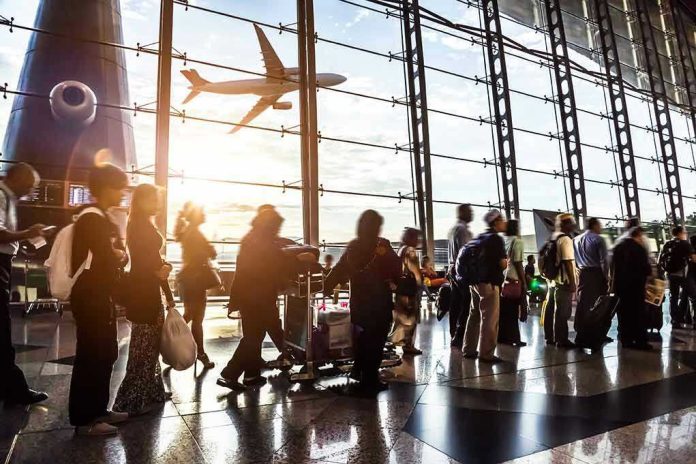
One cargo plane’s tail strike at 170 mph didn’t just rattle Heathrow’s runway—it sent shockwaves through global aviation, exposing how a single mishap can disrupt the heartbeat of international commerce.
Story Snapshot
- A DHL A300 freighter struck its tail at 170 mph landing at Heathrow, causing widespread operational disruption.
- Runway closures and flight delays rippled through one of the world’s busiest airports.
- Video of the incident fueled industry debate on cargo safety, pilot training, and weather protocols.
- Experts point to gusty winds, unstable approach, and systemic safety challenges for cargo operations.
Gusty Winds and a High-Speed Tail Strike Redefine Routine at Heathrow
October 12, 2025, marked an unplanned turning point for Heathrow Airport when a DHL Airbus A300, registration D-AEAG, attempted its final approach amid gusty weather. At barely 40 feet above the ground, a sudden gust destabilized the aircraft, forcing the left main gear to touch down first before the pilots corrected with a sharp nose-up pitch. That correction proved costly—the tail struck the runway at an astonishing 170 mph, a velocity rarely seen in commercial aviation tail strikes. The impact instantly triggered emergency protocols, closing the runway and sending delays and diversions echoing across the airport’s tightly choreographed schedule.
Within minutes, emergency services rushed to the scene. The aircraft, visibly damaged at the tail, was surrounded by fire crews and airport staff, who worked to clear debris and ensure no further hazards lingered. Heathrow’s operations came to a standstill as flights queued for takeoff and incoming aircraft either circled or diverted to alternative airports. Passengers and cargo shippers faced hours of uncertainty, as every minute of runway closure compounded downstream disruptions. Heathrow, a critical hub for both passengers and freight, felt the immediate sting of compromised capacity, reminding all stakeholders how vulnerable even the most robust systems can be to a single technical event.
Operational Disruption Exposes Fragility of Global Airport Networks
The incident did not merely inconvenience travelers—it spotlighted the delicate balance underpinning modern air transport. Heathrow’s role as the UK’s busiest airport, handling immense volumes of both people and goods, means any stoppage reverberates across continents. Airlines scrambled to rebook passengers, DHL rushed to inform customers of delayed shipments, and Heathrow’s authority coordinated with regulatory bodies to restore normal operations. The Civil Aviation Authority (CAA) swiftly launched an investigation, examining both the sequence of the landing and the protocols that allowed such an event to occur at high speed. Video captured by live aviation channels brought instant scrutiny and speculation, amplifying pressure on all parties to explain and resolve the disruption.
Cargo operations, which have surged post-pandemic, bring unique challenges. Large freighters like the A300 handle differently than passenger jets, especially when loaded. Gusty conditions at Heathrow, always a concern for pilots, proved a formidable adversary. While tail strikes are not unheard of, especially in unstable approaches or adverse weather, the speed and circumstances here reignited debate over landing procedures, go-around decisions, and the adequacy of crew training for cargo-specific scenarios. The absence of injuries did little to blunt industry concern; reputational stakes for DHL and Heathrow soared as news outlets and social media dissected every frame of incident footage.
Investigations, Industry Lessons, and the Road Ahead
As the runway reopened after thorough inspection and debris removal, the incident’s ripple effects persisted. Flight delays, rerouted cargo, and frustrated passengers taxed every part of Heathrow’s operation for hours. DHL’s immediate statement confirmed cooperation with authorities and a commitment to safety, while the CAA began piecing together the technical puzzle. Initial findings pointed to significant tail damage, yet the crew’s quick reaction may have averted a more catastrophic accident. Experts from aviation media and flight safety organizations weighed in—some lauded the pilots’ recovery, others questioned whether systemic gaps in weather forecasting or approach protocols contributed to the mishap.
Industry observers predict regulatory reviews and possible changes to landing criteria for cargo aircraft in gusty conditions. Pilots and operators face renewed scrutiny over the “stabilized approach” doctrine, especially at global hubs where any incident can disrupt thousands of lives and millions in commerce. For DHL, reputational recovery means demonstrating lessons learned and proactive safety improvements. Heathrow, meanwhile, must balance the demands of increasing cargo traffic with uncompromising safety standards, all under the watchful eye of regulators and the traveling public. As the investigation continues, the industry faces an open question: Are major airports prepared for the unique risks of cargo operations in unpredictable weather—or will Heathrow’s tail strike become a catalyst for deeper change?
Sources:
News report on the disruption and operational impact at Heathrow













